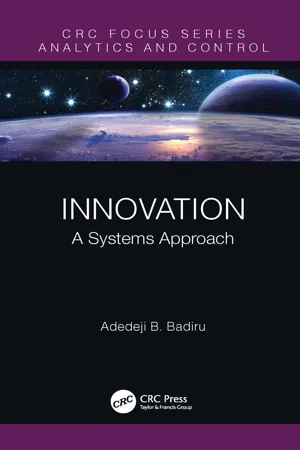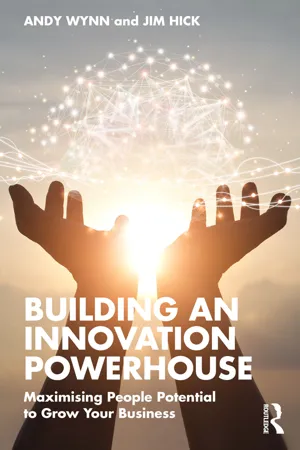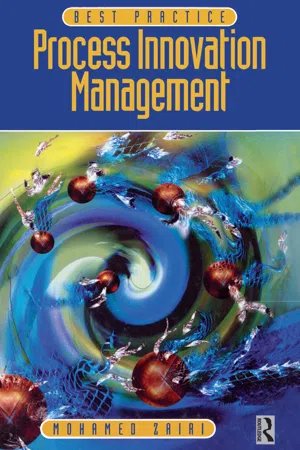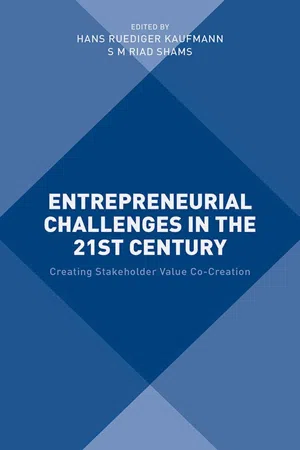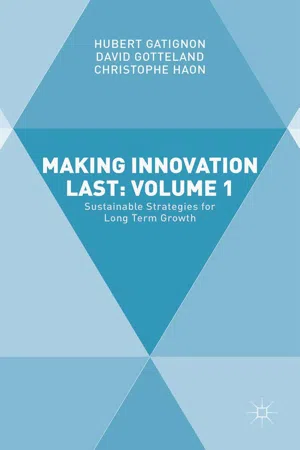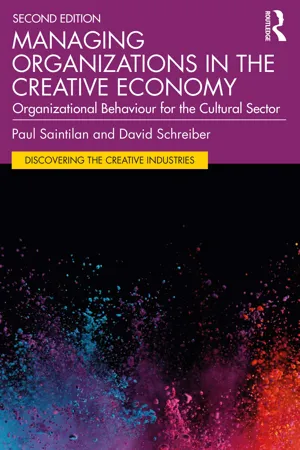Business
Innovative Organizational Culture
Innovative organizational culture refers to a work environment that encourages and supports creativity, risk-taking, and continuous improvement. It fosters a mindset of experimentation, adaptability, and openness to new ideas, leading to the development of groundbreaking products, services, and processes. This culture values collaboration, diversity of thought, and a willingness to challenge the status quo in pursuit of innovation.
Written by Perlego with AI-assistance
Related key terms
Related key terms
1 of 4
Related key terms
1 of 3
11 Key excerpts on "Innovative Organizational Culture"
- eBook - ePub
Leading and Transforming Organizations
Navigating the Future
- Kumaran Rajaram(Author)
- 2023(Publication Date)
- Routledge(Publisher)
Chapter 2 Value Creation Innovative Culture DOI: 10.4324/9781003286288-3 Organizations must advocate, and ingrain values that shapes an innovative culture with an outcome-based approach. They need to recruit talents that have such intrinsic motivation and values, but beyond that to comprehend the nuances to create the eco system and operational structure that inspires them to create the recurring value-creation effect. Kumaran Rajaram, PhD 2.1 Introduction Organizations pursue varying different forms and types of innovations. These innovations could be with regard to their products or services, internal processes, and business models, among other aspects (Purcell, 2019). Innovations remain essential for organizations today that exist in highly volatile environments. If companies do not embrace innovation and change, they will struggle to stay afloat with the rapidly changing and VUCA (volatility, uncertainty, complexity, and ambiguity) external environments. Convincingly, innovation brings plenty of benefits to the organization. The innovations serve as a means of growth, keep organizations relevant, and provide ways for them to differentiate themselves. Hence, an innovatively rooted culture is vital for organizations to build on. Innovation culture is defined as a multi-dimensional context that includes the intention to be innovative, the infrastructure to support innovation, operational level behaviors necessary to influence a market and value orientation, and the environment to implement innovation (Dobni, 2008). Successful organizations have the capacity to incorporate innovation, its practices into the organizational culture and management processes of the organization. In a nutshell, an innovation culture could potentially bring about varying benefits for an organization. 2.2 Innovative Culture Further to that, an innovative culture drives an outcome-based approach to value creation - eBook - ePub
Innovation
A Systems Approach
- Adedeji B. Badiru(Author)
- 2020(Publication Date)
- CRC Press(Publisher)
BusinessWeek , 2007), is considered a premiere leader in the development of the breakthrough spirit. With the recent emphasis being placed on innovation throughout the business world, it is not surprising that hundreds of articles and publications have been written on the characteristics of an innovative culture. Several common threads appear within the leading studies that help define the key characteristics: strong customer focus, collaboration, effective processes, creative people, inspiring leadership, risk-taking, and motivation/reward systems.- The right organizational structures
- The right processes
- The right people
- Inspired leadership
- Orchestration from the top
- Collegial culture with individual rewards
- Consistent business and technology integration
- Customer focus
- Teamwork and collaboration with others
- Appropriate resources
- Organizational communication
- Ability to select the right ideas for research
- Ability to identify creative people.
Strong Customer Focus
The research suggests that organizations who place their existing and future customers at the forefront tend to be more innovative. Strong customer focus does not just mean delivering what customers ask for but rather “capturing their ideas or actually allowing them to innovate on their own behalf” (American Management Association, 2006). According to Kelley and Littman (2001), co-founder of IDEO, true understanding comes not by talking to customers but by watching them and becoming immersed in their environment. As a result of this strong customer focus, organizations are in a better position to implement disruptive product and process innovations that transform the marketplace and decimate the competition. Demonstrating this point, Christensen and Raynor (2003) reviewed the extensive market analysis conducted by a quick-service restaurant chain with regard to milkshake sales. The group examined not just what the customers wanted, but why they wanted it, when they wanted it, who they were with, and what they would be doing if they were not there buying a milkshake. They essentially focused on the job the customer was trying to get done. - eBook - ePub
Building an Innovation Powerhouse
Maximising People Potential to Grow Your Business
- Andy Wynn, Jim Hick(Authors)
- 2022(Publication Date)
- Routledge(Publisher)
But culture is also a living thing, just like the people that create it, it develops, it grows and it evolves as new employees start, or people leave, as new strategies are announced, new organisational structures are rolled out and new projects and initiatives are started. All of these things change the nature of the people that form the culture and change the context within which the culture exists. And in just the same way that the development of a person can be shaped, influenced and directed by training, role modelling and suggestion, whether positively or negatively, so a company’s culture can be developed and directed, by reorganising reporting structures, terms and conditions of employment, incentives, and a thousand other things. Yet without a clear sense of where you are as a business and where you want to be, and without a plan of action to guide culture in the direction that will contribute positively to the future, all your actions as management will only serve to push and pull the culture in different directions, however well-meaning the decisions you make and act upon, leading to ambiguity and confusion for many employees in your business.So given this context of what culture means in terms of business, an innovation culture therefore describes the specific facet of the overall culture that is focused on promoting innovation within a company. Though I refer you back to the importance of first defining what innovation means to your business to avoid ambiguity and misinterpretation. If you have taken note of the previous two books in this series, then you should appreciate that for a business to grow through innovation, it needs an end-to-end innovation process in place that involves all departments, and an organisation that brings all functions into play to deliver on the processes, and therefore the innovation culture should truly span right across the organisation in a way that shapes and influences all those attitudes, behaviours and ways of working together that are woven into the culture, such that all employees want to contribute positively. This is critical for success because whilst the innovation processes give people the tools and the organisation sets the right environment it is the culture that makes people want to take part and deliver. - eBook - ePub
- Mohamed Zairi, Richard Duggan(Authors)
- 2010(Publication Date)
- Routledge(Publisher)
Closely allied to the concept of climate is culture. Organizational culture refers to deeply held beliefs and values. In one sense, therefore, culture is a reflection of climate, but operates at a deeper level. Where climate is observable in the practices and policies of the organization, the beliefs and values of culture are not, but exist as cognitive schema that govern behaviour and actions to given environmental stimuli. To illustrate the interlinkage, 3M has adopted the practice of setting aside a certain amount of time for employees to do creative work on their own initiative. To support this, specific seed funding is provided, and the individuals are encouraged to share and involve and become involved each other's projects. This environment of support (climate) makes individuals believe that senior management values innovation (culture). Culture thus appears to stem from the interpretations that employees give to their experience of organizational reality (why things are the way they are and the how and why of organizational priorities).If the notion of innovation culture is to be useful, it is important to be clear what we mean by the term. Failure to specify it clearly leads to confusion and misunderstanding. The question ‘What is innovation culture?’ is pertinent, yet complex, partly because of the way the concept has evolved and partly because of the inherent complexity within the concept itself. It is perhaps important to remember that the concept of corporate culture has developed from anthropological attempts to understand whole societies. The term came to be used to describe other social groupings, ranging from nations down to corporations and departments and even teams within businesses.There are many definitions of culture but most describe it as the pattern of arrangement or behaviour adopted by a group (society, corporation or team) as the accepted way of solving problems. As such, culture includes all the institutionalized ways and the implicit beliefs, norms, values and premises that underline and govern behaviour. - eBook - ePub
Entrepreneurial Challenges in the 21st Century
Creating Stakeholder Value Co-Creation
- S M Riad Shams, Hans Kaufmann(Authors)
- 2016(Publication Date)
- Palgrave Macmillan(Publisher)
The development of an enterprising culture is neither an easy nor a straightforward process, since there are numerous obstacles to overcome, most of which stem mainly from the features and the characteristics of the organizational culture. Innovative ideas, pioneering practices and the initiation of change, which constitute integral parts of an enterprising culture, may have a destabilizing effect, since they demand reconsidering, transforming or even confounding established organizational rules, routines and procedures and replacing them with new ones (Francis et al., 2011). This is a meeting with organizational inertia and innate human resistance to change and novelty. Staff members tend to appear reluctant to integrate changes – both incremental and radical ones – in their daily working routine for fear of their individual interest and professional welfare being detrimentally affected. Older and bigger organizations exhibit a greater propensity to remain reliant on established principles and work patterns, and to develop organizational systems, practices and structures that discourage innovation. However, the future should not be regarded as a linear extension of the present but as a set of discontinuities that entails both opportunities and threats and requires continuous adaptation.Value networks: enablers of learning and innovationContemporary organizations need to integrate the characteristics of the enterprising culture into their organizational culture. An enterprising culture is the precursor of business success and a crucial determinant of overall economic performance and sustainable competitiveness (Hundley and Hansen, 2012). Martin and Terblanche (2003) emphasize the fact that organizational culture can strongly influence the levels of innovation and entrepreneurship through a socialization processes that can beneficially affect workplace behavior and practices, and strengthen the organization’s capital and knowledge base. The establishment of an enterprising culture can significantly facilitate the creation and the effective management of a dynamic value-network that influences beneficially all aspects of organizational performance. A value network can be described as “any purposeful group of people or organizations creating social and economic good through complex dynamic exchanges of tangible and intangible value” (Allee, 2009, p. 429). Value networks can be internal, including relationships within and amongst different work groups and various departments of an organization, but they can also be external, involving an organization’s relationships with its customers, suppliers and investors. Moreover, powerful networks can be formed of various organizations or entrepreneurs of the same or similar industries as well as of individuals sharing the same professional or scientific interests, common goals or same hobbies. Value networks are regarded as critical to venture performance, and also as critical enablers of innovation, increased team productivity and knowledge sharing. Entrepreneurs and organizations can achieve higher rates of growth, creativity and innovation by learning how to work and co-create with networks of peers. - eBook - ePub
Multigenerational Communication in Organizations
Insights from the Workplace
- Michael G. Strawser, Stephanie A. Smith, Bridget Rubenking(Authors)
- 2021(Publication Date)
- Routledge(Publisher)
5 Perspectives on Organizational CultureThe remainder of the volume hinges on this chapter as the foundational component of the workplace. Organizational culture will be defined and presented within a historical context; then the authors will reflect on their findings and connect these findings to previous literature.5.1 Defining Organizational Culture
2020 arguably changed many personal and professional elements of the workplace. For one, suddenly, more than ever before, organizations were under attack for their values or lack thereof. As organizations learned to pivot, downsize, re-establish values, and communicate with various stakeholders, society at large was not the only group experiencing change. Organizations were under a cultural attack in many ways and were forced to reconsider all elements of the business, which collectively contribute to an organization’s culture.Organizational culture is a saturated area of study in management, business, and communication industries. Therefore, the definition of organizational culture can be complex and varied. Typically, organizational culture is defined as a set of values, beliefs, assumptions, and symbols that define the way in which a firm conducts its business (Deal & Kennedy, 1982 ). Organizational culture is important because it identifies the relevant employees, customers, suppliers, and competitors and defines how an organization will interact with these parties. Organizational culture has been correlated with competitive advantage (Barney, 1986 ), leadership (Schein, 2010 ), recruitment (Braddy, Meade, & Kroustalis, 2006 ), retention (Sheridan, 1992 ), and unethical behavior (Umphress, Bingham, & Mitchell, 2010 ), to name a few.Organizational culture helps us understand exactly how organizations accomplish goals and fulfill their missions and purposes (Sanchez, 2011 ). Culture is anecdotally referred to as “the way things are done around here,” similar to hearing “because I said so” from a parent while you were growing up. Organizational culture can seem arbitrary, but it is nonetheless pragmatic as defined by Trompenaars and Hampden-Turner (1997) - eBook - ePub
Effective and Creative Leadership in Diverse Workforces
Improving Organizational Performance and Culture in the Workplace
- Bethany K. Mickahail, Carlos Tasso Eira de Aquino, Bethany K. Mickahail, Carlos Tasso Eira de Aquino(Authors)
- 2019(Publication Date)
- Palgrave Macmillan(Publisher)
2017 ).Companies and individuals, understandably, have different plausible conceptions of how to develop an innovative culture . For example, in September 2017, a division Vice President and Chief Technologist at Corning R&D Corporation offered insights about creating an innovation culture , gained from many years of experience at various corporations. He discussed six ideas for developing an innovation culture: (1) “practice innovation parenting,” with creative organizational members, following a philosophy of laying out key organizational priorities and objectives, but providing flexibility to operate efficiently within those parameters as they see necessary, (2) “bust hierarchy,” to depart from traditional communication or staff interaction hierarchies and bureaucracies, (3) “encourage the unreasonable,” (4) “don’t die of indigestion” encouraging creative people or personnel to engage in innovation processes pursuing those projects within their capabilities to manage, (5) “cultivate external relationships” as they would expand the organizational knowledge, and (6) “hire the best and fast,” by aggressively “identifying, recruiting , and retaining” personnel essential to generate creative ideas and innovation (Ishak, 2017 , pp. 125–127).An innovative culture may also be developed through preplanned strategies such as five suggested by Wunker and Farber (2015 ) in the popular Forbes Magazine. Strategies suggested included: (1) understanding the type of innovation to pursue (“profit models, product, process, policies”), (2) precluding obstacles generated by the traditional hierarchies, (3) redefining traditional metrics and organizational rewards as they may not be suitable, (4) providing organizational members resources needed to present and channel novel ideas, and (5) creating “safe spaces” within the organization where creative ideas are encouraged and protected (Wunker & Farber, 2015 - eBook - ePub
- Marianne Chouteau, Joelle Forest, Céline Nguyen, Marianne Chouteau, Joelle Forest, Céline Nguyen(Authors)
- 2018(Publication Date)
- Wiley-ISTE(Publisher)
An organization’s culture can be defined as the set of standard habits, behaviors and representations shared by its members. This culture serves as social cement [CAM 11] for the life of the organization. It is also a powerful management tool that allows members of the organization to act independently and consistently [CHR 11]. The “innovation culture” is a particular configuration that makes innovative thinking natural within the organization and encourages innovation activities at the level of all employees. An analysis of the literature shows that the innovation culture has specific characteristics in five dimensions:- – the presence of innovative leaders and managers;
- – the presence of innovative teams;
- – the presence of innovative individuals;
- – an organizational context conducive to innovation;
- – multiple and easy links with outside of the organization.
These dimensions all rest on a foundation consisting of the innovator’s skills or discovery skills [CHR 13] (observe, question, network, experiment and associate) that must be disseminated at all levels of the organization. In the following sections, we detail the characteristics of each of the five dimensions of innovation culture.6.2.1. Innovative leaders and managersThe management of an organization’s culture is the responsibility of its leaders and making it evolve will first require changes that concern them personally [CAM 11]. For example, a company will not be able to progress from a traditional management mode to a self-governed type of management without the manager’s commitment [LAL 15] and a profound personal questioning [COL 16]. The most innovative organizations are led by innovators who have created products, developed discovery skills, and also believe they can change the world [CHR 13]. Leaders have an important role to play in supplying all company departments with innovative individuals [CHR 13] and in encouraging staff creativity as an initial step in innovation [AMA 96]. Moreover, each hierarchical level is likely to generate a variation in organizational climate. One unit can be much more innovative than another, simply because the manager creates the right climate [AMA 16]. Leaders and managers are therefore key elements in approaching an organization’s innovation culture. - eBook - ePub
Making Innovation Last: Volume 1
Sustainable Strategies for Long Term Growth
- Hubert GATIGNON, David Gotteland, Christophe Haon(Authors)
- 2015(Publication Date)
- Palgrave Macmillan(Publisher)
Part II Organizational Context for InnovationsPassage contains an image 4 Strategic and Market Orientations
The ability of an organization to systematically deliver successful innovations is not the result of luck but, rather, of providing a strong impetus for strategic directions that lead the organization to produce high-performing innovations, even given that some uncertainty does remain inherent in the innovation process. This means that the culture of an organization must reflect the values that will foster innovativeness throughout the organization. The second part of this book examines the nature of a culture of innovation and how to establish it throughout an organization in order to build the capacity for sustained delivery of high-performance innovations.In this chapter, we focus on the importance of creating a culture within the organization that pushes clear strategic directions that must be emphasized at all levels of the organization. We discuss how the choice of a strategic orientation by a firm impacts its innovation-producing effectiveness. A firm’s strategic orientation is defined as “the strategic directions implemented by a firm to create the proper behaviors for the continuous superior performance of the business” (Gatignon and Xuereb 1997, p. 78). The choice of strategic orientation determines the firm’s ability to innovate, to achieve radical product ideas, and to bring successful innovations to market. The strategic orientation of a firm is a dimension of the firm’s organizational culture, as reflected by the following definitions:- “The guiding principles that influence a firm’s marketing and strategy-making activities [and that] represent the elements of the organization’s culture that guide interactions with the marketplace” (Noble, Sinha and Kumar 2002, p. 25).
- eBook - ePub
Managing Organizations in the Creative Economy
Organizational Behaviour for the Cultural Sector
- Paul Saintilan, David Schreiber(Authors)
- 2023(Publication Date)
- Routledge(Publisher)
Chapter 13 Organizational culture in creative organizationsDOI: 10.4324/9781003262923-13Apple Inc.
Apple Inc. is a technological giant with strong links to the creative industries. It has been the technology company of choice for generations of designers and creative professionals and drove the digital transformation of the music industry through the iTunes platform and iPod. It is also a company that is widely seen to possess a strong corporate culture (Isaacson, 2011 ). When a company develops a culture that differentiates it from other companies and is motivational for attracting creative talent, staff and customers, it provides that company with a competitive advantage and a potential increase in its economic value.Figure 13.1 Apple Inc. Photo credit: TungCheung/Shutterstock.com .Former Apple leader Steve Jobs quickly fired employees who did not meet his high standards, creating an expectation of excellence and little tolerance for under-performance (Isaacson, 2011 ). This is an example of the behaviour of leaders becoming enshrined as a practice throughout an organization. Values that Steve Jobs tried to cultivate at Apple were: excellence, creativity, innovation, design elegance and simplicity, attention to detail, secrecy and confrontation where necessary to uphold excellence (Isaacson, 2011 ; Meyer, 2015 ; Thomke & Feinberg, 2009 ). These values became enshrined within the organization and came to define its culture.What is organizational culture?
One of the most popular and enduring definitions of organizational ‘culture’ is ‘the way we do things around here’ (Bower, 1966 ). The Apple example above shows a particular approach and style of working based on shared assumptions, meaning and values. The management theorist Henry Mintzberg has described culture as ‘the spirit of the human hive’ (Mintzberg, 2013 - eBook - ePub
- Jin Chen, Alexander Brem, Eric Viardot, Poh Kam Wong, Jin Chen, Alexander Brem, Eric Viardot, Poh Kam Wong(Authors)
- 2019(Publication Date)
- Routledge(Publisher)
Most researchers emphasise the importance of the organisational culture and climate for creating innovations. Stimulating innovative activity requires a specific organisational culture. The climate and innovative culture determine the creative possibilities of the organisation, because from them flows the inclination of employees to take innovative endeavours. Organisational culture is defined as a set of created norms developed on the basis of the assumptions, values, and norms of the models of operation, showing employees how to achieve the company’s goals. The basic cultural patterns conducive to innovation are openness to risk, change; willingness to experiment; tolerance of uncertainty; and the use of opportunities, creativity, trust, cooperation, mutual support and error tolerance. What is also important is the autonomy in action, validation, freedom to submit ideas, supporting new ideas, and tolerating discussions on the submitted ideas (Brilman, 2002, p. 172).Thus, in enterprises with an innovation culture, employees deal with uncertainty themselves, based on their own knowledge, skills, and experiences, and dynamic networks of cooperative ties are created.The innovative climate is focused on the development of employees, including the assessment of their qualifications, skills, and potential. An organisation with such a climate has a flexible organisational structure, where formalism and strict subjection to regulations and organisational procedures are reduced to a minimum. There is a cult of professionalism, risk tolerance, freedom in action, individualism, and permission to take risks and be innovative. Moreover, there is a large tolerance for errors, because it is thanks to them that the organisation can access new solutions. The goals of the organisation are treated by the employees as challenges (Ekvall and Ryhammar, 1999). The role of the management staff is to encourage and stimulate the employees to submit their own ideas for improving the work or products or services offered by the organisation. Non-formal channels of communication and free flow of information between employees and their superiors are also promoted. This is to enable employees to disclose and exploit their creative potential.Another factor that may increase the chances of building an efficient innovation team is trust. Trust is defined and interpreted in various ways in the literature. According to a psychological approach, it is a kind of mental state that is related to the willingness to take risks and accepting them. It can also mean being ready to be sensitive to the actions of the other party based on the belief that the other party has done specific actions important to the trusting party, which are independent of the ability to monitor and control. It is also readiness based on the assessment of the other party’s credibility in a situation of interdependence and risk.
Index pages curate the most relevant extracts from our library of academic textbooks. They’ve been created using an in-house natural language model (NLM), each adding context and meaning to key research topics.
Explore more topic indexes
Explore more topic indexes
1 of 6
Explore more topic indexes
1 of 4

